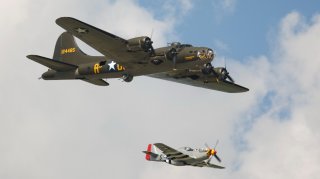Efforts to Restore World War II B-17 “Desert Rat” Bomber Underway
Rome may not have been built in a day, and restoring a B-17 is something that takes time.
There is no denying that the B-17 Flying Fortress played a significant role during the Second World War. Yet, a common misconception is that it was the most produced heavy bomber of the conflict. It wasn’t; in fact, that distinction rightfully goes to the B-24 Liberator.
In total, 18,482 Liberators were produced during the war, while just 12,731 Flying Fortresses were built between 1936 and 1945. However, both aircraft proved to be the true workhorses of the United States Army Air Forces (USAAF), and were used in every theater of combat operations. And while both bombers have their fans, thanks to toys, movies and video games it is the B-17 that has captured the hearts and imagination of aviation buffs for some eighty years.
Yet today, seeing an actual B-17 isn’t exactly that easy—and seeing it in the air is almost unheard of. That’s because just forty-six B-17 bombers survived in complete form and only ten remain airworthy.
The heartbreaking October 2019 crash of the restored “Nino-O-Nine” B-17 at Bradley International Airport in Windsor Locks, Connecticut, which resulted in seven dead including both the pilot and co-pilot, made some question whether the vintage warbirds are actually airworthy. In addition to the tragic loss of life, the aircraft was nearly completely destroyed by fire.
New Restoration Efforts for Desert Rat
The number of complete Flying Fortresses could increase as there are now efforts to restore a B-17E that had been built by Boeing in Seattle during World War II. The aircraft had been used as a cargo plane after the war ended, and was then retired and sold for scrap. That particular aircraft had been discovered in a Maine junkyard in 1985, and the decision was made to restore it.
Nicknamed the “Desert Rat,” this B-17E never actually flew over North Africa. Rather it had been accepted by the USAAF in February, 1942 and was assigned to the 97th Bomb Group as a crew trainer. It was then transferred to the 383rd Bomb Group before being deployed as a staff transport. However, as one of the few remaining B-17s the efforts are now underway at the Vintage Aviation Museum in Morengo, Illinois.
Rome was not have been built in a day, and restoring a B-17 is something that takes time.
Mike Kellner and his team of volunteers at the museum have been steadily working away on the restoration of Boeing B-17E Flying Fortress 41-2595 for much of the past four decades. Progress of the efforts can be seen on the Auto Archaeology YouTube Channel.
Even with volunteers, the efforts are still costly as numerous parts need to be fabricated and the museum expects that at least another $225,000 is required—a notable number as the unit cost for a B-17 bomber during in 1945 was $238,329. Of course that would be $2.8 million in 2021 dollars! To help raise funds, the restoration team has taken on side projects including building B-17 related items for sale to aviation collectors.
It could still be years before the Desert Rat is able to take flight, but these efforts serve as a reminder that the history of the contribution made by the B-17 and the countless aircrews who flew the bomber during the war won’t be soon forgotten.
Peter Suciu is a Michigan-based writer who has contributed to more than four dozen magazines, newspapers and websites. He regularly writes about military small arms, and is the author of several books on military headgear including A Gallery of Military Headdress, which is available on Amazon.com.
Image: Reuters

